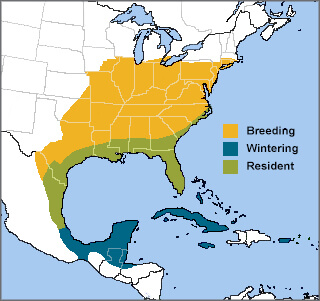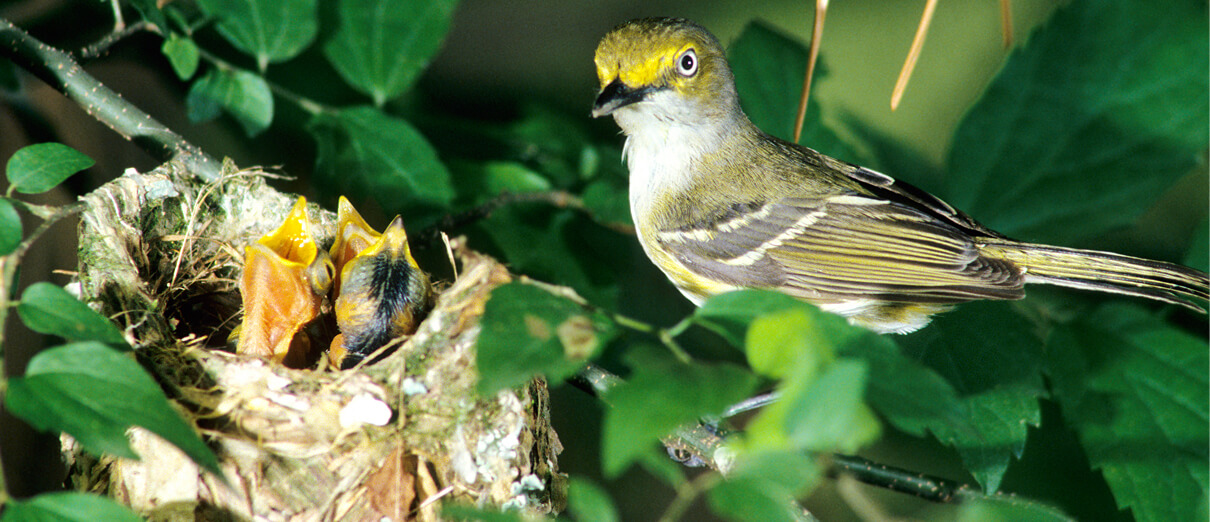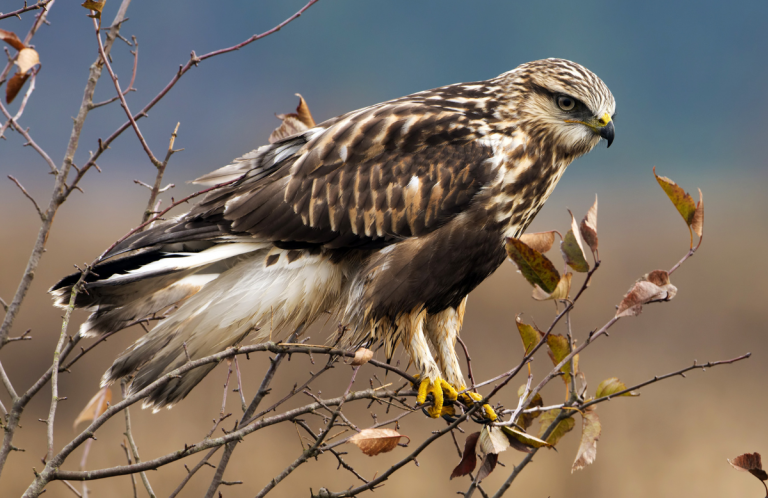
White-eyed Vireo range map by ABC
The elusive White-eyed Vireo is a bird of dense, scrubby habitats. Like the Yellow-breasted Chat, this yellow, gray, and white bird is more often heard than seen. But this vireo is just as curious as another denizen of thick foliage, the Common Yellowthroat. Like that species, it can sometimes be lured into view with a few squeaking noises. A quick glimpse of this vireo reveals a stocky little bird with a thick, slightly hooked dark gray bill and yellow "spectacles" surrounding somewhat fierce-looking white eyes.
An Intense Stare
The White-eyed Vireo is one of only a few passerines in North America with white eyes. Another species, the Wrentit, is also found in densely vegetated habitats, but in a rather limited range along the West Coast and in Northern Mexico. In addition, Eastern Towhees in the southeastern U.S. have white eyes, instead of the species' “usual” red. Also, female Bushtits have pale, whitish eyes. Some blackbirds, such as the Rusty Blackbird, have pale eyes that are usually referred to as yellowish.
The white eye color of this vireo is characteristic of an adult bird. Young White-eyed Vireos are gray-eyed, and only attain white eyes in their second year.
Charming Chatterer
The White-eyed Vireo nests across much of the eastern and central United States and in northeastern Mexico. Six subspecies are recognized, varying in size and color. White-eyed Vireos breeding along the Gulf Coast are resident (nonmigratory), while more northerly populations retreat to the southern U.S. and tropics for the winter. One subspecies of White-eyed Vireo is found only in Bermuda, where it is known as the "Chick-of-the-Village," an onomatopoeic translation of this bird's chattering vocalizations.
The loud, distinctive song of the White-eyed Vireo is an explosive jumble of notes, typically beginning and ending with a sharp chik sound. This song is often described as "per-chick-a-WOW-chick!" Other descriptions include "quick-with-the-beer-check!" and "sit, sit-behind-a-white-oak, sit." The White-eyed Vireo also mimics the call notes and, less often, the songs of other bird species, and incorporates them into its own vocalizations. Males are the only singers during the breeding season, but both sexes sing during the winter.
Listen to the White-eyed Vireo's abrupt song here:
(Audio: Russ Wigh, XC570175. Accessible at https://www.xeno-canto.org/570175 · Brad Banner, XC614740. Accessible at www.xeno-canto.org/614740)
Switching Diets
Like the related Red-eyed Vireo and many other migratory birds, the White-eyed Vireo switches diets according to the season. During the breeding season, it consumes a wide variety of insects, spiders, and even small lizards; in the fall and winter, it adds seeds and berries to the menu.
The White-eyed Vireo forages by slowly hopping and flitting through dense undergrowth. Prey is captured with a quick lunge or short hovering flight.
Cowbird Concerns
Each spring, the male White-eyed Vireo stakes out a territory and begins to incessantly sing from conspicuous perches to attract a mate. Females will make the rounds of several territories, eventually settling on a suitable territory and mate for the season.
The female White-eyed Vireo chooses a nest site in a shrub or young tree, usually within eight feet of the ground. The male and female build a cup-shaped, slightly pendulous nest in the fork of a thin, horizontal branch. The nest is built of leaves, roots, twigs, bark, and paper, lined with softer materials and bound in flexible spider webs, which expand as the pair's hatchlings grow. The female lays three to five eggs, which both parents take turns incubating. Both parents also raise the young birds, which usually leave the nest within two weeks.

White-eyed Vireo at nest. Photo by Danita Delmont/Shutterstock
Like many other small songbirds, the White-eyed Vireo is a frequent host of the Brown-headed Cowbird, a brood parasite, or species that lays its eggs in other birds' nests. Larger cowbird hatchlings usually outcompete vireo chicks, which die of starvation or are pushed out of the nest.
Saving Vireo Habitats
Although the White-eyed Vireo remains fairly common, it is still vulnerable to habitat loss. Its favored habitat of shrub, hedgerow, and secondary forest is rarely protected, and often cleared. Outdoor cats are a significant threat to this bird because of its tendency to nest low, and migrating White-eyed Vireos are frequent victims of collisions with structures such as communications towers.
ABC provides a number of resources to help reduce these threats. ABC's Cats Indoors program advocates for responsible pet ownership and works to educate the public and policy makers about the many benefits to birds, cats, and people when cats are kept indoors.
Our collisions program helps to prevent communications tower collisions and fatalities, and provides solutions to prevent bird collisions with glass, particularly at home windows.
In addition, we are involved in a number of large-scale conservation initiatives to protect and recover habitat on breeding and wintering grounds, including BirdScapes and Joint Ventures.
Donate to support ABC's conservation mission!



















































